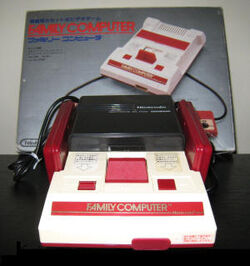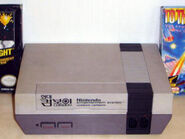| Family Computer System (Famicom)/Nintendo Entertainment System (NES) | |
|---|---|
 A Japanese Famicom | |
|
Type: |
Console |
|
Release date: |
1983 |
|
Discontinued: |
1995-2003 |
|
Operating system: |
None |
|
CPU: |
MOS 6502 |
|
Memory: |
2 KB RAM |
The Nintendo Entertainment System (also abbreviated as NES) is an 8-bit video game console that was developed and manufactured by Nintendo. It was initially released in Japan as the Family Computer (ファミリーコンピュータ Famirī Konpyūta?) (also known as the Famicom (ファミコン Famikon?) and abbreviated as FC) on July 15, 1983, and was later released in North America during 1985, in Europe during 1986, and Australia in 1987. In South Korea, it was known as the Hyundai Comboy (현대 컴보이) and was distributed by SK Hynix which then was known as Hyundai Electronics. It was succeeded by the Super Famicom/Super Nintendo Entertainment System.
History[]
In the late 1970s, Nintendo, then an experienced maker of electronic games, noticed the success of programmable video game consoles as well as the huge success of the ColecoVision in 1982 with one of their own games, Donkey Kong, being the pack-in with the console. They decided to get involved in this success, first by exclusively distributing Magnavox Odyssey consoles in Japan, then by making their own console, the Family Computer, or Famicom. This console was intentionally made to look like a toy and was released strictly in Japan only. It took 60 pin cartridges.
Nintendo CEO at the time, Hiroshi Yamauchi, initially wanted a machine created that could out-do the many other electronic games on the market. He gave this task to Masayuki Uemura, saying he would like a console with a 16-bit processor and disk drive while still being affordable (about US$75). Unfortunately, including these features would have costed far too much, so instead they went with an 8-bit processor and the disk drive came later as an add-on called the Famicom Disk System.
The Famicom was released in Japan in July 1983 at a price of US$100. The first games released were Donkey Kong, Donkey Kong Jr and Popeye but by the end of 1983 they had made enhanced versions of Donkey Kong Jr and Popeye that allowed 2 players, and they had released Baseball and Mario Bros as well as a Go game and an adult title.
In its first year of release, the Famicom was often found to be quite an unreliable console with numerous bugs and freezing problems. Yamauchi did not want this system's future to be threatened and so he recalled all sold systems and stopped further production until the problems were fixed. Famicom was re-released with a new motherboard but the same familiar design.
In 1984 Nintendo felt it was time to bring their console to America. They asked Atari to market the Nintendo Advanced Video System, an Americanised version of the Famicom, but they were developing their own machine at the time so Nintendo later hired Worlds of Wonder to distribute the NES when it was released the next year.
At CES in June 1985, after the Video Game Market Crash, Nintendo released their console as the Nintendo Entertainment System to American audiences with extreme scepticism. Nintendo had to promise retailers that they would buy back all unsold systems as they were weary that no-one would buy after the crash and the push towards home computers. The console was redesigned to look less like a toy and was front-loading with larger, 72-pin cartridges. Test-marketed in New York, the 100 000 consoles sold out quickly.
When the NES was officially released, Nintendo also released R.O.B. (Robotic Operating Buddy) and called the NES a "Robotic Games System" in order to keep people interested in video game consoles. The console could be bought with R.O.B., a light gun and three games for US$249, or you could buy just the console and Super Mario Bros for US$199. Many other packages came later as the console was released in different countries.
Being one of the few systems on the market after the crash and having Super Mario Bros as the pack-in game meant that the NES would be very successful, which it was, out-selling its competitors 10 to 1.
The NES outdid the Sega Master System and Atari 7800, both of which came after. The Famicom and NES were later redesigned as the AV Famicom and New NES. This idea was a way of selling a few last consoles before production stopped and was a cheaper alternative to the Super NES.
Because the NES lived so long, the games kept getting better and better as programmers gained better knowledge and equipment to produce games. In the end more than 50 million consoles and over 350 million games sold. There were many interesting accessories made for this console.
Hardware[]
| Processor Type | Processor Speed | Other Processor Information | RAM \ Video RAM |
| NTSC: Ricoh 2A03 PAL: Ricoh 2A07 (both 8-bit custom MOS 6502) |
NTSC: 1.79 MHz PAL: 1.66 MHz |
NTSC: RP2C02 PPU (5.37 MHz) PAL: RP2C07 PPU (5.32 MHz) |
2 KB \ 2 KB |
| Screen Resolution | Color Palette | Polygons \ Sprites | Audio |
| 256 x 240 | 52 (25 on screen) | 64 sprites (max on-screen) | PSG Sound (5 Channel) Mono |
| Media Format | Media Capacity | Games Released | Other Supported Formats |
| Cartridge | 1 Mib | Approx. 1,050 | Famicom Disk (with optional add-on) |
| Internal Storage | External \ Removable Storage | Game Controllers | Other Game \ Peripheral Devices |
| None | None | D-Pad, 2 Action buttons, Start & Select buttons | Modem, Light Gun, Power Pad, Power Glove, Keyboard, R.O.B., Modem |
| Controller Ports | Network Ports | Other Ports | Audio \ Video |
| Two (2) | None (connectivity with optional Famicom Modem - Japan only) | Expansion Port | RF (Composite on later models) |
| Power Supply - External | Other Outputs | Other Details \ Notes | |
| Input: AC 110\120V, 60Hz Output: DC 9V 1.3a |
None | Modem, Keyboard and optional Famicom Disk System were only made available in Japan. | |
Software[]

A Cartridge (or "Game Pak") for the NES with Super Mario Bros. 3
The Nintendo Entertainment System offered a number of groundbreaking titles. Super Mario Bros. pioneered side-scrollers while The Legend of Zelda helped popularize battery-backed save functionality.
Valis games released for the Platform
- Mugen Senshi Valis/Valis I (Japan only)
Gallery[]
Trivia[]
- The Famicom/NES is the console with the most released pirated games and clone consoles.
- This console's version of Valis I was the first console game of Valis ever made, and also considered one of the worsts.








